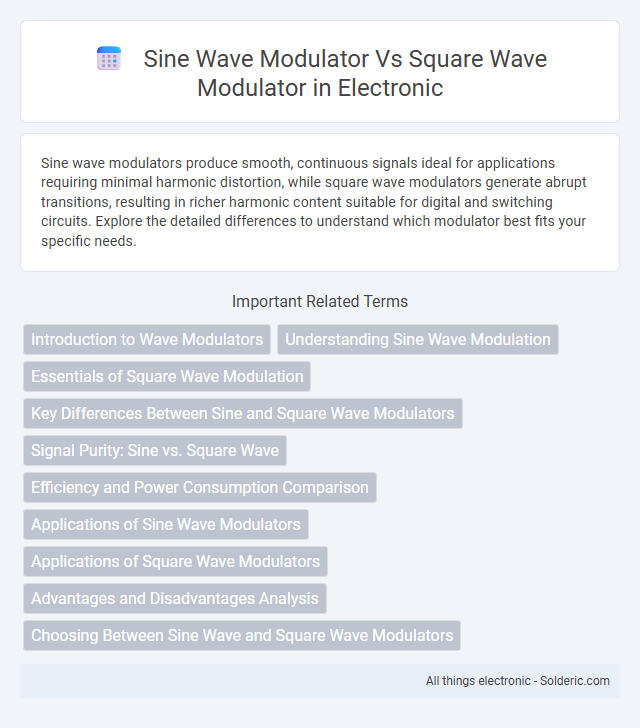Sine wave modulators produce smooth, continuous signals ideal for applications requiring minimal harmonic distortion, while square wave modulators generate abrupt transitions, resulting in richer harmonic content suitable for digital and switching circuits. Explore the detailed differences to understand which modulator best fits your specific needs.
Comparison Table
| Feature | Sine Wave Modulator | Square Wave Modulator |
|---|---|---|
| Waveform | Continuous smooth sinusoidal signal | Discrete, alternating high and low levels |
| Harmonic Content | Low harmonic distortion, fundamental frequency dominant | High harmonic distortion with odd harmonics |
| Signal Accuracy | High accuracy in signal representation | Lower accuracy due to abrupt transitions |
| Power Efficiency | Moderate power consumption | Generally higher efficiency due to switching nature |
| Applications | Audio modulation, RF communication, analog systems | Digital modulation, clock generation, switching circuits |
| Complexity | More complex circuitry required | Simple circuitry, easier implementation |
| Interference | Less electromagnetic interference (EMI) | Higher EMI due to sharp transitions |
Introduction to Wave Modulators
Wave modulators shape signal waveforms for communication and control applications, with sine wave modulators producing smooth, continuous oscillations essential for analog signal fidelity. Square wave modulators generate rapid, discrete transitions useful in digital switching and pulse-width modulation due to their sharp rising and falling edges. Choosing between sine and square wave modulators depends on system requirements such as signal clarity, harmonic content, and power efficiency.
Understanding Sine Wave Modulation
Sine wave modulation produces smooth, continuous signals ideal for analog communication due to minimal harmonic distortion and efficient bandwidth usage. In contrast, square wave modulation generates abrupt transitions causing significant harmonic content and potential interference in transmission systems. Understanding sine wave modulation is crucial for optimizing signal clarity and reducing noise in various communication applications.
Essentials of Square Wave Modulation
Square wave modulation generates signals with abrupt transitions between high and low states, creating a waveform rich in harmonics and ideal for digital signal applications. Its essential characteristic is the rapid switching that results in efficient power usage and simpler circuit design compared to sine wave modulators. You can optimize communication systems by choosing square wave modulation when high-speed switching and efficient power consumption are priorities.
Key Differences Between Sine and Square Wave Modulators
Sine wave modulators produce smooth, continuous signals with less harmonic distortion, making them ideal for applications requiring high signal fidelity and minimal interference. Square wave modulators generate signals with sharp transitions, offering easier digital signal processing and simpler hardware implementation but introducing higher harmonic content that can cause noise. Understanding these key differences helps you choose the appropriate modulator based on your system's requirements for signal quality and complexity.
Signal Purity: Sine vs. Square Wave
Sine wave modulators generate signals with smooth, continuous waveforms that produce high signal purity and minimal harmonic distortion, making them ideal for applications requiring clean and precise signals. Square wave modulators create waveforms with abrupt transitions, resulting in significant harmonic content and increased signal distortion, which may interfere with sensitive equipment. Your choice between sine and square wave modulation should consider the importance of signal purity in your specific system to ensure optimal performance.
Efficiency and Power Consumption Comparison
Sine wave modulators typically exhibit higher efficiency in power conversion due to their smooth waveform, which reduces harmonic distortion and minimizes power loss in reactive components. Square wave modulators, despite simpler implementation, often consume more power as their abrupt transitions generate significant harmonics, leading to increased filtering demands and heat dissipation. Efficiency ratings for sine wave modulators commonly exceed 90%, whereas square wave modulators may operate at efficiencies closer to 70-85%, impacting overall energy consumption in applications.
Applications of Sine Wave Modulators
Sine wave modulators are widely used in communication systems for their ability to produce smooth, continuous signals ideal for analog transmissions, such as AM and FM radio broadcasting. Their low harmonic distortion and spectral purity make them preferred in audio equipment, signal processing, and oscillators. Your choice of a sine wave modulator enhances signal quality and reduces interference in sensitive electronic applications compared to square wave modulators.
Applications of Square Wave Modulators
Square wave modulators excel in digital communication systems and pulse-width modulation due to their efficient switching characteristics and ease of signal generation. Their distinct high and low states enable precise control in power electronics, motor drives, and signal processing applications, minimizing signal distortion. You benefit from using square wave modulators in scenarios requiring robust, stable, and straightforward modulation techniques for efficient data transmission and control.
Advantages and Disadvantages Analysis
Sine wave modulators provide smooth, continuous signal variations, resulting in lower harmonic distortion and improved spectral efficiency, making them ideal for high-fidelity communications. Square wave modulators offer simpler circuit design and easier implementation but generate high harmonic content, leading to significant electromagnetic interference and reduced signal quality. The choice between the two depends on application requirements, balancing signal purity against hardware simplicity and cost.
Choosing Between Sine Wave and Square Wave Modulators
Choosing between sine wave and square wave modulators depends on the application requirements, with sine wave modulators offering low harmonic distortion and smooth signal transitions ideal for audio and communication systems. Square wave modulators are preferred in digital and switching applications due to their rapid rise and fall times that enable precise timing and efficient power conversion. The decision relies on balancing signal purity and efficiency against switching speed and spectral properties for optimized system performance.
sine wave modulator vs square wave modulator Infographic

 solderic.com
solderic.com